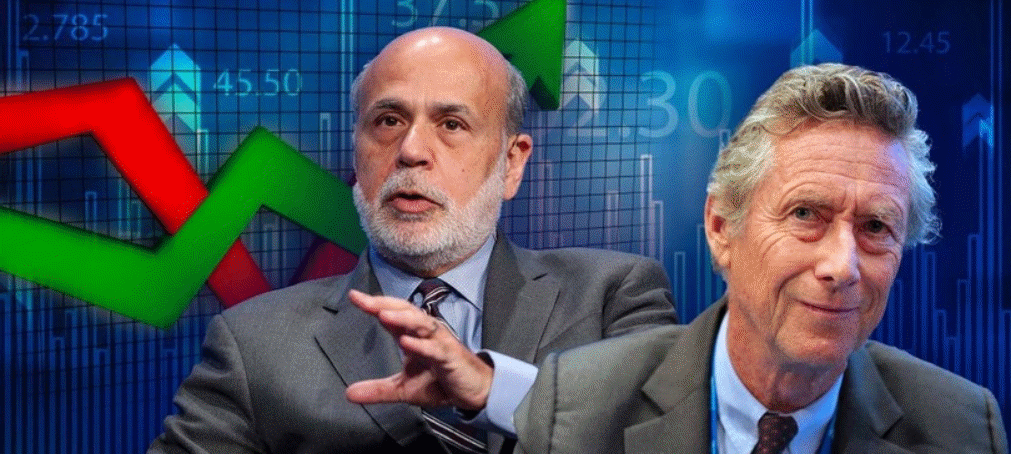By Michael Roberts
A recent paper by mainstream heavyweights, Ben Bernanke (former Federal Reserve chief) and Olivier Blanchard (former chief economist at the IMF) has raised some eyebrows. Bernanke and Blanchard seek to argue that the inflationary spike in the US since the end of Covid pandemic slump was down to a sharp rise in ‘aggregate demand’ and not due primarily to supply blockages and weak productivity recovery in key sectors that I and others have argued – and certainly not due to ‘greedflation’, ‘price gouging’ or corporate profit mark-ups.
The claims on inflation from Bernanke and Blanchard
This is what they argue: “Ultimately, as many have recognized, the inflation reflected strong aggregate demand, the product of easy fiscal and monetary policies, excess savings accumulated during the pandemic, and the reopening of locked-down economies.” So the inflation burst was due to too much fiscal spending during the pandemic; too easy monetary policies (low interest rates) and a build-up of savings which were then spent in the recovery period.
So nothing to do with supply-side issues, then. But yet B&B go on to say that “initially, the inflation reflected primarily developments in product markets. To the extent that excessive aggregate demand set off the inflation, it did so primarily by raising prices given wages, through its contribution to higher commodity prices (which reflected other forces as well, including the war in Ukraine) and by increasing the demand for goods for which supply was constrained.” So inflation was kicked off by rising commodity prices, supply constraints and then the war in Ukraine – so supply-side issues after all!
Was it caused by excessive wage increases feeding through to prices? No, say B&B. “Our decomposition shows that, as of early 2023, tight labor market conditions still accounted for a minority share of excess inflation.”
Their three contributory factors analysed
In particular, their decomposition of prices “yields several conclusions. First, the contributions of food and (especially) energy price shocks to the pandemic-era inflation were large. Energy price shocks in particular account for much of the rise of overall inflation in late 2021 and the first half of 2022, and the for the decline in inflation in the second half of 2022.” So again, it was commodity prices, not ‘aggregate demand’.
“Second, the combination of increased demand for durables and shortages associated with disrupted supply chains was the dominant source of inflation in 2021Q2, and the effects of supply chain problems, both direct and indirect, remained significant through the end of our sample period.” So it was also supply chain blockages.
“Third, and importantly, the contribution to inflation of tight labor-market conditions—the leading concern of many early critics of U.S. monetary and fiscal policies—was quite small early on, and indeed was negative in 2020 and early 2021 as labor markets suffered from the effects of the pandemic recession.” So ‘tight labor markets’ and excessive wage demands played no role in raising inflation – on the contrary.

But B&B are concerned to ensure that the conventional mainstream theory is retained, namely that it is wage rises that cause inflation rises. They go on “over time, as the labor market has remained tight, the traditional Phillips curve effect has begun to assert itself, with the high vacancy-to-unemployment ratio becoming an increasingly important, though by no means dominant, source of inflation.” Even here, they temper their claim (“by no means dominant”). They must do so, because the graph above shows how small wage pressure has been (red block) compared to energy (dark blue) and food prices (light blue) and supply shortages (yellow).
Bernanke and Blanchard are against workers defending the real value of their wage
What B&B want to push though is that now in 2023, attempts by workers to compensate for huge price rises hitting their real incomes by using their bargaining power in ‘tight labor markets’ will cause inflation to stay high. “according to our analysis, that share (wage share – MR) is likely to grow and will not subside on its own. The portion of inflation which traces its origin to overheating of labor markets can only be reversed by policy actions that bring labor demand and supply into better balance.”
So the tortuous policy of hiking interest rates by the Fed to ‘control inflation’ must be supported and maintained. “labor-market balance should ultimately be the primary concern for central banks attempting to maintain price stability”. In other words, weaken workers’ bargaining power by increasing unemployment through higher costs of borrowing to spend or invest.
Ironically, having advocated monetary tightening as the answer to inflation, apparently caused by excessive ‘aggregate demand’, they finish by saying that “Policymakers must be alert to the possibility that inflationary pressures can come from product markets as well as labor markets, for example, through unexpected changes in input costs or shifts in demand that collide with inelastic sectoral supply curves.”
Indeed. But don’t let that ‘possibility’ stand in the way of mainstream Keynesian theory on the causes of inflation and on the supposed efficacy of central banks hiking interest rates to ‘control inflation’ caused by factors beyond their control.
From the blog of Michael Roberts. The original, with all charts and hyperlinks, can be found here.



